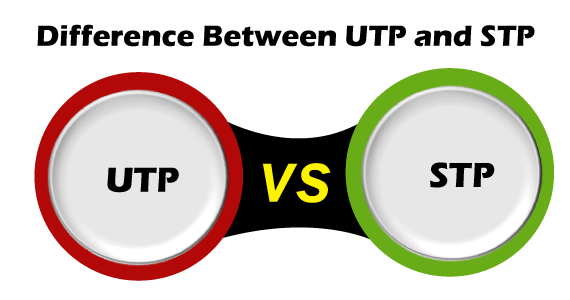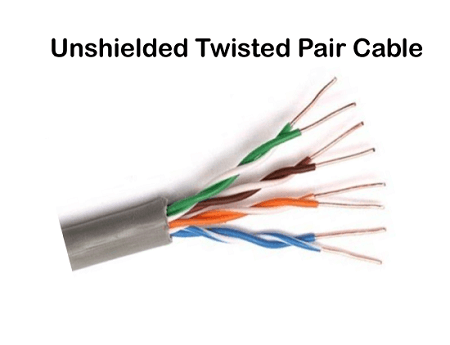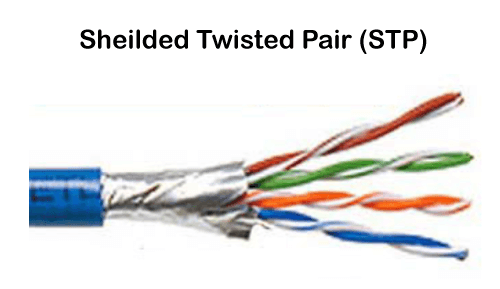Difference between UTP and STP
Before going through the difference between UTP and STP cable, we need to learn the term twisted pair cable. A twisted pair cable is a widely used cable for transmitting data and information over certain distances. A twisted pair cable consists of two separate insulated copper wires that are twisted together within a wrapping shield and run parallel with each other. Furthermore, it helps to reduce the crosstalk or electromagnetic induction between the pair of wires. A twisted pair cable is divided into two parts as STP and UTP.

UTP (Unshielded Twisted Pair)
UTP is an unshielded twisted pair cable used in computer and telecommunications mediums. Its frequency range is suitable for transmitting both data and voice via a UTP cable. Therefore, it is widely used in the telephone, computers, etc. It is a pair of insulated copper wires twisted together to reduce noise generated by external interference. It is a wire with no additional shielding, like aluminium foil, to protect its data from the exterior.

Advantages of the UTP:
- It is a less costly and less expensive unshielded wire from another network medium.
- It is designed to reduce crosstalk, RFI, and EMI.
- Its size is small, and hence the installation of the UTP is easier.
- It is mostly useful for short-distance network connections like home and small organizations.
- It is the most commonly used networking cable in the market. It is considered as faster copper-based data transmission cable.
- It is suitable for transmitting both data and voice via UTP cable.
Disadvantage of the UTP:
- It can only be used in length segment up to 100 meters.
- It has limited bandwidth for transmitting the data.
- It does not provide a secure connection for data transmitting over the network.
STP (Shielded twisted pair):
A shielded twisted pair is a type of twisted pair cable that contains an extra wrapping foil or copper braid jacket to protect the cable from defects like cuts, losing bandwidth, noise, and signal to the interference. It is a cable that is usually used underground, and therefore it is costly than UTP. It supports the higher data transmission rates across the long distance. We can also say it is a cable with metal sheath or coating that surround each pair of the insulated conductor to protect the wire from external users and prevent electromagnetic noise from penetrating.

Features of Shielded twisted pair cable:
- Frequency: It has higher frequency data transmission as compared to the UTP.
- Thickness: It is a thick shielded twisted pair cable as it contains the wrapping of plastic material to the copper conductor.
- Grounding practices: The uses of shielded twisted pair cable are underground for a longer distance.
- Installation of the shielded wire is more difficult than the UTP (Unshielded twisted pair) cable.
Advantages of the STP cable
- It has lower noise and attenuation than UTP.
- It is shielded with a plastic cover that protects the STP cable from a harsh environment and increases the data transmission rate.
- It reduces the chances of crosstalk and protects from external interference.
- A modular connection helps to terminate the connection of the STP cable.
Disadvantages of the STP cable
- It is the most expensive wire from UTP cables.
- It requires more maintenance to reduce the loss of data signals.
- There is no segment improvement in length despite its thick and heavier connection.
- It is used only as a grounded wire.
Difference between UTP and STP
Following are the differences of the UTP and STP, as follows:
| UTP |
STP |
| It is an unshielded twisted pair. |
It is a shielded twisted pair. |
| UTP cable is a twisted pair cable with wires that are twisted together. |
It is enclosed within a foil or mesh shield. |
| The price of UTP is lower as compared to the STP. |
The price of STP is much costlier than UTP. |
| It does not require a grounding cable. |
It requires a grounding cable. |
| In UTP, the electromagnetic interference is more than the STP while transferring the signal to the transmission media. |
It reduces electromagnetic interference while transferring the signal to the transmission media. |
| UTP has high crosstalk. |
STP has low crosstalk. |
| Transferring speed of the data signal is slow as compared to the STP. |
Transferring speed of the data signal is high as compared to the UTP. |
| Installation of UTP cables is easy as they are lighter, small in size, and flexible. |
Installation of STP cable is quite difficult as compared to the UTP. Its size is heavy, bigger, and stiffer. |
| It does not require much maintenance. |
It requires more maintenance. |
| UTP cables are noisier. |
STP cables are less noisy. |
| However, the UTP cable is used to establish the connection within a short distance, like a home or small industry. |
Generally, it is used to establish the connection for enterprises over a long distance. |
|



 For Videos Join Our Youtube Channel: Join Now
For Videos Join Our Youtube Channel: Join Now










